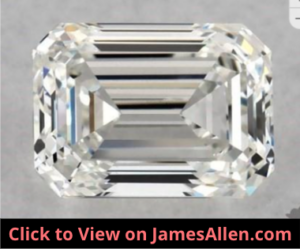- By Jacob Clarke
- jacob.clarke@teachjewelry.com
- Last Updated: April 9, 2023
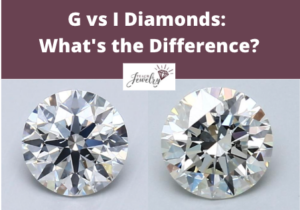
G and I are two grades in the “near colorless” section of the Gemological Institute of America’s (GIA) color scale.
The main difference between G and I color diamonds is G diamonds show a lighter amount of yellow. Diamonds with I color grades sometimes have apparent yellow, and as a result, sell for a lower price. G diamonds often appear identical to colorless ones without magnification.
In this article, we’ll compare G vs I color diamonds, including:
- An overview of each
- Five differences
- How to decide which is right for you
Let’s dive into the details.
What to Know About G Color Diamonds
G color diamonds are in the fourth highest position on the GIA color scale. They’re one position above H and below F.
Although they’re considered near colorless, it’s generally difficult to pinpoint yellow when viewed with the naked eye.
To see a real example, check out this G color diamond, from the vendor where I found my wife’s engagement ring.
Rotate the high-resolution image 360 degrees, zoom in as closely as you can, and try to identify any color.
It’s more apparent when it’s placed next to a true colorless diamond. Here’s a side-by-side comparison of a G and D color diamond.
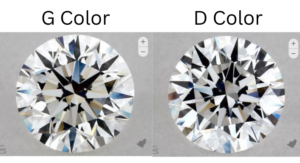
In that view, the slight tints are more noticeable because of the diamond on the right.
G color diamonds are a popular choice for engagement rings because of their value and lack of color.
You’ll avoid the price premium for D, E, and F diamonds, but it’ll be tough to tell them apart when viewed in a normal setting.
What to Know About I Color Diamonds
I color diamonds are in the sixth position on the GIA color scale, below H and above J. Within the “near colorless” section, it’s third from the top.
Here’s where it’s located on the scale.

In many cases, I diamonds show minor tints of yellow to the naked eye. It’s especially obvious when it’s placed next to a G and D diamond.
Here’s an image comparing them.
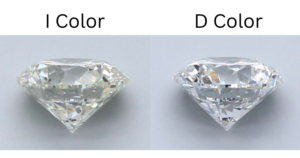
To view one up close, check out this I diamond, and rotate it.
No matter which angle you examine, you’re likely to identify the yellow.
The color is often more obvious in larger diamonds. For example, if you’ve chosen a setting with accents graded I, they’ll typically appear colorless because the facets are so small.
On the other hand, if your two-carat engagement ring diamond has an I color grade, it likely will show yellow when you evaluate it closely without magnification.
How are They Different From Each Other?
1. G Diamonds Show Less Yellow Compared to I
When gemologists examine diamonds, they view them up close with 10x magnification and compare them to master stones that represent the ideal form of each grade.
Even though the untrained eye might have difficulty distinguishing between G versus I color diamonds, the former shows less yellow through its facets.
The difference between grades next to each other on the GIA color scale is often minimal.
In fact, professionals often disagree on the exact color grade, which underscores why a rigorous process is paramount.
But with H color diamonds sitting between G and I, gemologists are less likely to view them as the same.
As an example, here’s the two placed next to each other.
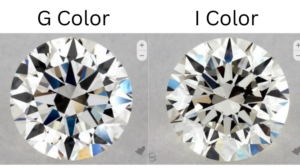
At a quick glance without magnification, they might appear identical, but a more thorough examination indicates the G diamond is closer to colorless.
2. I Diamonds Sell for a Lower Price
I color diamonds cost less compared to G because buyers are willing to pay a premium as they approach colorless.
In general, each step up the Gemological Institute of America (GIA) color scale increases the price by five to 15 percent.
But I’ll provide real examples from James Allen, a leading online jeweler who has thousands of G and I diamonds listed as part of their inventory. It’s also where I bought my wife’s engagement ring.
I compiled prices for 221 I color diamonds with the following characteristics:
- Carat weight: 1.00
- Clarity: VS2
- Cut: Ideal
The average price was $4,758. The range was from $3,430 to $6,360.
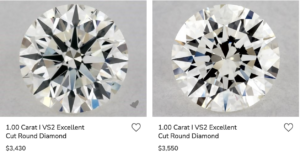
I also compiled prices for 253 G diamonds with those same qualities.
The average price was $6,205, with the lowest at $4,880 and the highest at $8,510.
That’s a 23 percent lower price for I versus G color diamonds.
That savings could be put toward a heavier carat weight or improved clarity or cut grades. Or you could embellish the setting with additional diamonds or choose platinum or white gold.
I’ll generally point my readers toward H and G color diamonds for the price savings compared to the colorless category, but if you find an I diamond that appears colorless, it offers tremendous value.
In my case, I chose a D color diamond for my wife’s engagement ring, which results in a substantial premium over G or I.
In hindsight, I could’ve settled for a lower color grade and enhanced the overall piece elsewhere.
3. G Diamonds are More Fit for Fancy Shapes
Fancy shaped diamonds are any cut other than round. Examples are:
- Marquise
- Princess
- Radiant
- Cushion
Fancy shapes often show more color than round cuts because they produce less brilliance, or white light. Step cuts, such as emerald, baguette, and Asscher cuts, produce even less light than brilliant fancy shapes.
That’s why I recommend choosing a G color fancy shape diamond over one that earns at I grade.
To illustrate, here’s an I color emerald cut diamond.
There are shades of yellow visible in high resolution.
As a comparison, here’s one graded G.
In that close-up view, there’s still some yellow visible, but there’s an obvious difference between them.
Your goal shouldn’t be to choose the highest color grade within your budget. Instead, it’s often prudent to choose the lowest grade that’s identical to colorless without magnification.
Fancy shaped diamonds under two carats with G color grades generally meet this criteria, but perform your diligence on the exact diamond you’re considering.
If you’re choosing a round cut, you could explore H, I, or J diamonds for the right value.
4. G Diamonds are More Rare
Most diamonds have significant color.
There’s enough yellow or brown that you wouldn’t expect to see them on top of an engagement ring.
If you move to the top of the color scale to D and E, you’re in rare territory. In fact, they represent only one or two percent of diamonds.
This pattern is true as you move up the color scale, so G diamonds are more common compared to I. The lack of color, which is a trait most diamonds don’t feature is what makes them more valuable to buyers and results in a higher price.
If you’re shopping for a diamond at any local or online jeweler, you’ll likely find fewer available as you move up the color scale.
Availability is partly driven by supply and demand, but it’s also because there aren’t many diamonds that earn the premium grades.
5. I Color Diamonds are Less Popular for Engagement Rings
I color diamonds aren’t as common for engagement rings because buyers generally want less yellow.
Diamonds in the colorless category have tangible and intangible value, but the premium price causes many to move down slightly.
That lands them at G, where it appears nearly identical to the three grades above but is less expensive.
It what makes a G color diamond one of the most popular for engagement rings.
That being said, I still recommend starting with lower grades and searching for value. You can always work your way up the scale if you can’t find one that meets your criteria.
How to Decide Between a G or I Diamond
If you’re deciding between diamonds with G and I color grades, the primary factor to consider is how their differences in yellow tints affect its overall appeal.
If the diamond is heavier than 0.5 carats, you’ll likely notice the distinction with your naked eye.
Here are some tips to guide your decision.
Consider a G diamond if:
- You’ve chosen a fancy shape that doesn’t display as much brilliance
- The diamond is heavy enough to require a higher color grade than I to appear colorless
- You’re willing to pay a premium compared to lower grades
An I diamond might be right for you if:
- The diamond is small enough to hide any shades of yellow
- You want to search for one that offers exceptional value because of its low price and colorless appearance
- You’re interested in a diamond that has light tints of color
Explore both color grades in person and at online vendors.
Pair G and I color diamonds with settings to learn how they fit as your piece of jewelry.
When it comes to choosing between G and I color diamonds, it's all about balancing personal preferences, budget, and the overall aesthetic you're aiming for. G color diamonds offer a near-colorless appearance that can be quite appealing, especially for engagement rings or other significant pieces of jewelry where the diamond is the focal point. On the other hand, I color diamonds present a value opportunity; their slight warmth can be a beautiful complement in the right setting, and may allow for budget flexibility in other areas such as carat weight or design intricacies. It's essential to view diamonds of both color grades in person or through high-resolution imagery online to truly understand the color difference and make an informed decision that aligns with your desires and budget.
Chuck Harris - Teach Jewelry Team Member
G vs I Color Diamonds Q&A
Q: How does the metal choice impact the appearance of G vs I color diamonds?
A: The choice of metal can affect the perceived color of G and I color diamonds. For instance, yellow or rose gold settings may complement the warmer tones of I color diamonds, while white gold or platinum settings could enhance the near-colorless appearance of G color diamonds.
Q: How do G and I color diamonds compare in terms of investment value?
A: G color diamonds, being closer to colorless, might hold their value better over time compared to I color diamonds. However, the lower price point of I color diamonds could offer a more affordable entry into diamond ownership.
Q: What are the considerations when choosing between G and I color diamonds for different types of jewelry like earrings, necklaces, or engagement rings?
A: For pieces like engagement rings, where the diamond is a focal point, a G color diamond might be preferable for its near-colorless appearance. In contrast, I color diamonds might be more suitable for earrings or necklaces, where the slight color may not be as noticeable, or may even be desirable depending on personal preferences and the overall design of the jewelry.
Q: How does the size of the diamond affect the perception of color in G and I color diamonds?
A: Larger diamonds may exhibit more noticeable color, which means the color differences between G and I might be more apparent in larger stones. Smaller diamonds may show less color, making the difference between G and I less noticeable.

Jacob Clarke
Jacob Clarke is the founder of TeachJewelry.com.
He earned an Applied Jewelry Professional Diploma from the Gemological Institute of America (GIA) and now brings you essential information about diamonds, settings, and more.
Jacob has consulted with leading jewelry brands, and his work has been cited in Clean Origin, Diamond Nexus and industry publications.
He's also a member of the International Gem Society.
He enjoys discussing jewelry with readers, so contact him with any questions at jacob.clarke@teachjewelry.com.


